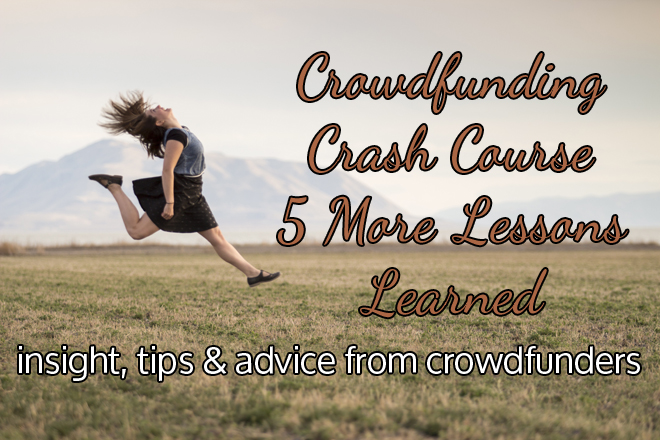Tagged: crowdfunding
How to Plan & Run a Successful Crowdfunding Campaign (part three)
- by Alyson Shane
Welcome back to the third instalment of the Crowdfunding Crash Course series!
This series of summary posts is designed to go over the lessons learned through more than a dozen interviews with crowdfunders during the course of this project, all with a little bit of insight from myself (of course.)
This instalment will focus on a few things to do after your campaign ends, so let's begin!
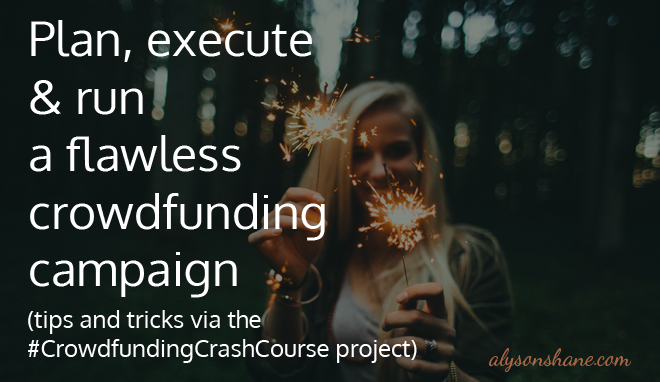
Thank Your Backers - No Matter What the Outcome
If your campaign succeeded, congratulations! You kicked some ass, took names, and raised your funding goal. At this point it's crucial to reach out to all of your backers at every level and thank them for contributing to your project and supporting you in your endeavours.
However, if your project was unsuccessful reach out anyway. Be honest with your backers. If you used Indiegogo or a service which allows you to keep the funds you raised, let them know how you plan to spend the money. If you used a service like Kickstarter and you know they'll be getting a refund, reach out and thank them sincerely. If you can, let them know what your next steps are and how they can continue to follow and support your project beyond the campaign.
Remove a Failed Kickstarter Campaign Before It Ends
If you're using Kickstarter and you know a few days before your campaign end date that you're not going to meet your funding goals, shutter your campaign and regroup before it ends. Otherwise you'll be left with a dead, unfinished campaign that will sit on Kickstarter indefinitely.
This was one of the things that Meghan Athavale mentioned in her interview. She said that initially she tried to raise funds using Kickstarter, but didn't plan enough and unfortunately the first time around her team didn't meet their funding goals.
However, what she didn't realize was that she couldn't remove her failed campaign after it ended, which means that when she re-launched an Indiegogo campaign, even though she was significantly more prepared and met her funding goals this time, she still had an old, failed ghost of a campaign out in the ether of the internet. If you think that this is something that could cause issues for you in the future, cut your losses and end your campaign while you still have the chance.
Map It Out!
The overarching theme of this project seems to be plan as much as humanly possible (have you noticed?)
Do-to lists, checklists, all those tools come in handy when planning a campaign of any sort, but the old classic tool is still one of the best: a calendar with all of your important dates, milestones, and reminders plugged into it.
If you're a bit old school like me you might like to physically write things down when you plan, but if you'd like to keep things digital (way easier when working with a team) Indiegogo has a fabulous calendar tool which you can use to plan your campaign well in advance and make sure you don't miss any important dates or milestones.
It's also pretty helpful if you're new to this whole experience and are unsure of when you should be planning each step. Personally I think the timelines are a bit aggressive -I'd give myself a few months to adequately plan, instead of just a few weeks- but that's entirely up to you and how prepared you are!
Learn the Tools of the Trade
This factors into what we talked about in the 2nd recap post, where we discussed the importance of having a game plan to promote your campaign and manage it before you start. Doing your research into the best platforms and tools to help you craft, create, and distribute your message to the masses can make or break your campaign.
Below are a few great resources to get you started:
Video Creation & Editing: iMovie or Stupeflix
Video Hosting: Vimeo or YouTube
Landing Pages: Unbounce
Social Media Management: Hootsuite, Buffer, Crowdbooster, SocialFlow, Sprout Social
Link Shortening: Bit.ly, Snip.ly
Want even more?
I'm thrilled to announce that I'm in the process of putting together The Crowdfunding Crash Course eBook!
As I was putting together this post I found myself having to go back through posts and interviews I'd written, and sift through them to find the information I wanted. It was clunky, confusing at times, and not at all the kind of succinct, awesome experience that I want to provide for all of you.
So, with a very limited knowledge of iBooks Author, I set out on a quest to put together the most complete version of the Crowdfunding Crash Course project to date, all compiled in a handy little book for you to reference and use whenever you need!
The eBook is full of tips, tricks, breakdowns and, of course, the interviews from the Crowdfunding Crash Course Project. In addition to the information already available in post format, I'll be providing a more detailed breakdown and analysis of each campaign, as well as additional insights and advice to prepare for, and manage your campaign after it's ended.
The Crowdfunding Crash Course eBook will be available for free to all of my newsletter subscribers, make sure you sign up to get your hot little hands on one of the first copies!
I'm so excited to be sharing this news with you, and can't wait to get The Crowdfunding Crash Course eBook out there into the big, wide world!
xox
Alyson
How to Plan & Run a Successful Crowdfunding Campaign (part two)
- by Alyson Shane
Welcome back to the second instalment of the Crowdfunding Crash Course recap series!
In this series we'll be covering the lessons that the participants of the Crowdfunding Crash Course project shared with us, all summed up in a few handy posts (with some input from yours truly, of course.)
If you think you have an amazing idea that you have to share with the world, it might seem like crowdfunding is the easiest way to get your message out to a lot of people. Spoiler alert: it isn't. A successful crowdfunding campaign is rarely one that you can "set and forget" and takes about as much planning and preparation as a run-of-the-mill marketing campaign.
Honestly though, I didn't fully grasp any of this until I started this project. This is because a good crowdfunding campaign, like most things that are done well, looks pretty effortless.
This realization is why I decided to start doing recap posts - to help dispel some myths about the process, and to break down the steps to take to make sure that your campaign is every bit as successful as it can be!

Do Your Research
Luckily for us, neither Kickstarter nor Indiegogo, the two most popular crowdfunding platforms, automatically remove campaigns once they've ended. This is great news for you, a budding crowdfunder, because it means that there's a wide variety of projects to explore and research. If you're lucky, there may even be a few similar to what you're planning to do, which can be great opportunities for some research.
For example, if you're planning a crowdfunding campaign to raise money for your nonprofit which will develop a product to be used in developing countries, you'd be doing yourself a disservice if you didn't take a look at the SolarPuff Kickstarter campaign page, and that's just one that we know about! A quick search for "nonprofits" will bring up a variety of campaigns for you to draw inspiration from.
The best part about the fact that all those older campaigns are still out there is that it gives you an idea as to how different campaigns managed to meet their funding goals... or if they didn't.
Some things to check for are:
- The quality and length of of the video
- Message and story
- The strength of the pitch (or the "ask")
- The kinds of perks offered at the start
- If any perks were added any later into the campaign
- If the campaign met it's funding goals (or if it didn't, how close it came)
Crowdfunding, as an industry, is unusually transparent because everything is out there in the open for all to see. Campaigns, by their nature, are public, and the information is there for you to learn from. All you have to do is take the time to do your research!

Pick the Best Platform to Suit You
The two major crowdfunding platforms out there are Kickstarter and Indiegogo, and because the interviews I did for this project happened to all be on either platform, these are the two we'll focus on right now.
Kickstarter is an "all or nothing platform" which means that if you set your crowdfunding goal as $100,00.00 and you only manage to raise $95,000.00, you don't get to keep any of it. In fact, when someone donates to your campaign their credit card isn't charged until your campaign reaches it's goal.
Indiegogo has what's called a "flexible funding system," which means that as backers donate to the campaign, the organizers get that money in real time. It also means that they get to keep the money that's been backed so far, regardless of whether or not you reach your goals. Indiegogo also allows you extend the life of your campaign, and change your funding goals halfway through your campaign.
Kickstarter dwarfs Indiegogo in a few key ways: it attracts more traffic, it features a "Projects We Love" newsletter and feature area on their site which can propel a floundering project well past it's target goal, and it attracts more pledges, and pledges in higher amounts.
However, Indiegogo has it's strengths: it's had almost 100,000 more successfully completed campaigns than Kickstarter; this is because when a campaign is about to expire and hasn't reached it's funding goal, many people pull them from Kickstarter before the end-date.
Ultimately the platform you choose is up to you! Do your research and invest your time in the platform that you think will do the following:
- Allow you to provide the kinds of rewards you'd like
- Has funding options that you're comfortable with
- Provides you with ways to promote your campaign
Work With a Team
One of the striking things about the interviews I did for this project was the sheer amount of man-power that goes into planning, executing, and managing a crowdfunding campaign.
Running a campaign takes a lot of time and effort. You have to plan before your launch, manage the marketing leading up to and during the campaign, communicate with funders, answer questions, and any variety of things that might pop up or be unique to your project.
According to Indiegogo, crowdfunders who worked with teams of three or more raised over three times as many funds as campaigners who chose to go at it alone. This is likely because having more people on your team means you have an extended network of people to share it with, and potential funders!
It never hurts to have each member of your team promoting your campaign on their own individual social media feeds, and to their friends and family; even more incentive to surround yourself with a great team of people to help your campaign be a success!
Communicate Consistently
Nothing makes a backer feel like they wasted their money more than a campaign that goes dark the moment you donate. Besides that, you don't want people to forget about your campaign the second they give you money, do you? Of course not, which is why communicating is so, so important.
One of the most effective things you can do to keep things fresh is to keep updating your campaign page after you launch. This is essential! Regardless of the type of project you're trying to fund, you want to keep your backers in the loop every step away (this plays into what i was saying earlier about crowdfunding being an extremely "transparent" industry).
This means updating your page when you've hit important milestones, have press mentions, or new perks that you've added after the campaign launch (more on that in the next instalment, I promise!).
Updates to your campaign will automatically be emailed to anyone who contributes, making this step a total breeze and the easiest way to communicate with your backers post-launch. It also helps your backers know that you appreciate them and their efforts in helping you succeed.
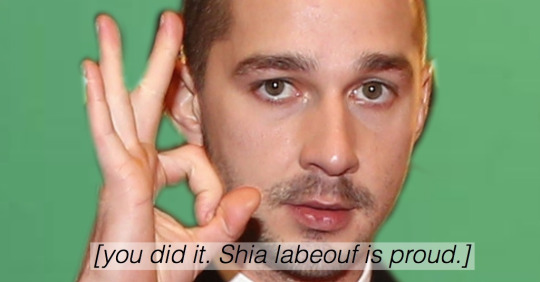
On average, most crowdfunding campaigns post at least four updates over the course of their campaign, and these posts could cover a wide variety of topics, such as:
- Important funding milestones (30%, 50%, etc)
- New perks and incentives
- Profiles of that terrific team you've put together
- Behind-the-scenes looks at your process, product development, etc
- Press coverage
- and more!
Staying in touch with your backers is key, and can often help put you over the top of your funding goals during those final, stressful days of your campaign. If you send an update to your backers which reads "only $200 to go until we've met our goal!" and that backer is emotionally (and financially, now) invested in seeing your campaign succeed, they're much more likely to forward the email to others and ask friends to donate to that awesome, super-cool campaign, too!
Is That It?
Heck no! There's still more to cover, so make sure you check back to the final instalment of the Crowdfunding Crash Course Recap Series
This post is part of a series. For all of the Crowdfunding Crash Course interviews and summary posts, visit the Projects section of my site!
How to Plan & Run a Successful Crowdfunding Campaign (part one)
- by Alyson Shane
The Crowdfunding Crash Course project has reached it's end. I've interviewed over a dozen crowdfunders about a variety of topics, ranging from art projects, to tech hardware, to books, to board games, music and more.
To say that this has been a learning experience is putting it lightly. I've learned so much over the course of these interviews, and am excited to be able to share what I've learned with you, especially now that the interview portion of the project has reached completion.
Over the next few posts we'll discuss, in-depth, some strategies and steps to take to help you with the following:
- Gauging interest and pre-campaign community-building
- How to stay organized and on track
- Maintaining momentum during your campaign
- Telling an emotionally compelling story
- and more!
Ready? Let's get started!

Build a Community
One of the most common responses that I heard during the course of this project was "build your community first."
While building your community factors into your marketing and outreach, I want to touch on it, separately, because one-time funders might not do much to improve your campaign's visibility. Sure, they may donate and help you reach your funding goal, but if they don't talk to their friends about it or share it on social media, they aren't being as helpful to your campaign as they could be.
Communities form online when like-minded people get together based on a shared goal, vision, or interest. In the case of your campaign, your goal is to create a community of supporters dedicated to seeing your campaign succeed.
This goes beyond your mum, your partner and your best friend. In order to blow past your goals and leave the competition in the dust, you'll have to create an engaging, compelling campaign which mobilizes people to actively support and share it with everyone they know. More on how to do all of this below:
Plan Your Marketing & Outreach
Crowdfunding platforms aren't listing services, and the success and results you'll see will be directly proportional to the amount of time, attention, and planning you put into promoting your campaign elsewhere online.
Meg Athavale, who used Indiegogo to fund the LUMO Interactive Projector, a gaming and display system that includes a projector, a sensor that captures motion data, and an Android processor, used tools like Gleam, Thunderclap, and Facebook ads to raise awareness. She also went "old school" and attended events and conferences where she met potential investors, and secured a spread story in the Canadian newspaper the Globe and Mail, which helped increase awareness.
Some tools to use to keep in mind while planning your campaign's marketing strategy are:
- Hootsuite, Buffer, or a similar content-scheduling app
- Facebook and Twitter Ads
- MailChimp, for newsletters and campaign updates
- Thunderclap, for outreach
- Gleam, to run competitions to raise interest
Focus on the Pitch and Story
Once you get people to your page, the most important part of crowdfunding is your initial pitch, and your message.
It's important to remember the context of crowdfunding: you're competing with countless other crowdfunders on a single website, wether that's Kickstarter, Indiegogo, or whatever platform you're using. You're not just competing against other crowdfunders, but on the internet at large. The only thing stopping potential funders from navigating away from your page is your message.
How can you craft a message that makes people stay? You have to tell a great story. A great story doesn't just tell people what you're doing, it should also tell them how their support helps make a difference. Focusing on appealing to the "why" of your campaign, and engage your funders on an emotional level.
One of my favourite examples of this was SolarPuff: A Unique Little Solar Light. Stacy Kelly, who was interviewed about the project, mentioned that when the Nepal earthquake hit, they were able to integrate the SolarPuff into relief efforts. For Stacy's funders, knowing that their donations were going to develop and distribute a product that would help people in need made them feel good, which helped increase engagement and donations.
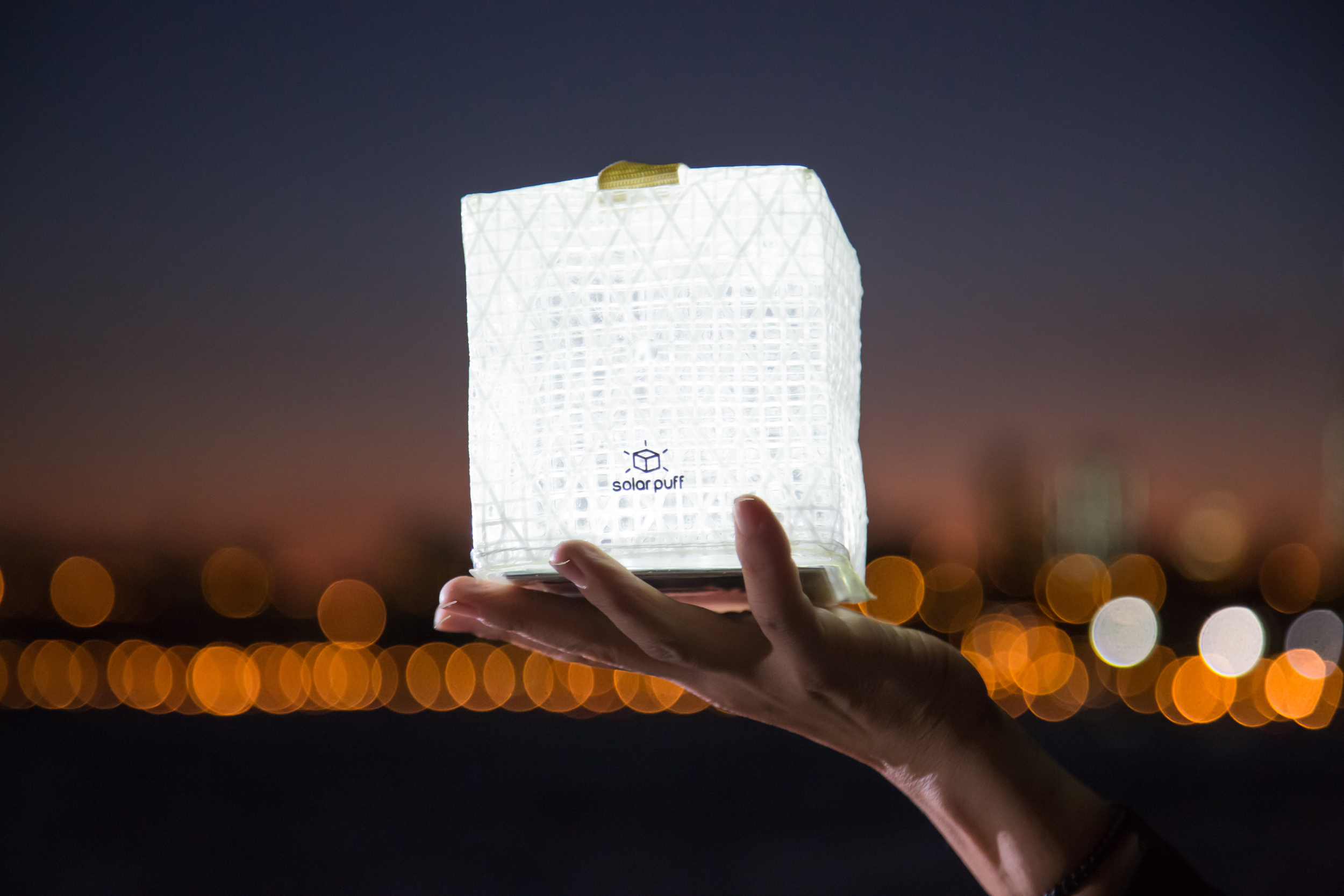
Additionally, in the case of SolarPuff the nature of the product -an eco-friendly, reusable, solar-powered light which could be used for emergency relief aid- earned them a spot on Kickstarter's "Projects We Love" list, which skyrocketed their funding thanks to the exposure.
It's unlikely that Kickstarter would have featured the SolarPuff if they didn't have the emotional appeal, strong pitch, and story behind it. Having a product and a story with emotional appeal always helps.
Build An Email List
A strong email list is one of the best and most powerful tools at your disposal to promote your campaign on an ongoing basis, from before it starts to after it's finished. Before your campaign begins, set up a landing page on your site which features a video (more on that below), a call to action, and a field where people can sign up for newsletter updates to the project.
Having an email list is the most effective way marketers have to promote something, because when a person signs up to receive regular updates they're giving you the keys to the most personal place on the internet: their email inbox. You now have a direct line of communication with that person, which they've willingly given to you.
Having email newsletters means that you can communicate on the status of your campaign before it starts, when it's launching, and important milestones and successes as they occur, as well as calls-to-action to donate. A strong email list also is a very good indicator that there's interest in your product and idea, which can be a great way to gauge interest before you begin investing all that time and energy.

Put Effort Into Your Video
Videos are your best tool to communicate with your audience, and to help them understand your message, goals, and how your campaign will make a difference in their lives. Your video is the single best tool at your disposal to connect with your audience, pull them in, and hook them emotionally.
Things to focus on include:
- Image quality
- Music (something simple and generic is best)
- Shots of the product in action
- Members of your team
When producing your video, shoot two different endings: one before the campaign launches, which you can use to promote the campaign before you start, and another for when the campaign is live.
The first ending should invite people to sign up for email updates on your upcoming crowdfunding campaign, and should be posted on social media, your website, forums, and other areas where people can find it 2-6 months before your campaign launches. This will give you lots of lead-time to build an email list, and provides you with a strong piece to convey your message early on.
The second ending should be used when you post your video to the campaign page. This ending should invite people to contribute, re-iterate your pitch, goals, and message, and include a call to action for people to share the campaign on their own social feeds.
Tell Your Story
Tell your story before you ask for money.
In your text and in your video, if you've made one, focus on your story and your enthusiasm for your project. Introduce the members of your team, and let them explain why this project is important to them.
Don't worry too much about being wooden and formal - people like to laugh, and if your story can make them smile, or even laugh, they'll relate to you and your goals much more easily. Your funders want to feel like they can relate to you, and your cause, and being your silly, enthusiastic self will help tremendously.
Explain to your audience why funding your particular project will make them feel good and how they'll see a return on investment, either by being the first to access a new technology or product, supporting an artist they love, or by participating in a large-scale event like relief efforts which will help other people.
Is That It?
Of course not! But that is it for this post. Crowdfunding is a complex and fascinating new way to promote ideas and projects and raise money, and there's a lot more to discuss, but this post is getting a bit long in the tooth and nobody likes walls of text.
With that in mind, stay tuned for pt2 of the Crowdfunding Crash Course recap, coming soon!
This post is part of a series. For all of the Crowdfunding Crash Course interviews and summary posts, visit the Projects section of my site!
Crowdfunding Crash Course: Alex Tinsley - Knit It Black
- by Alyson Shane
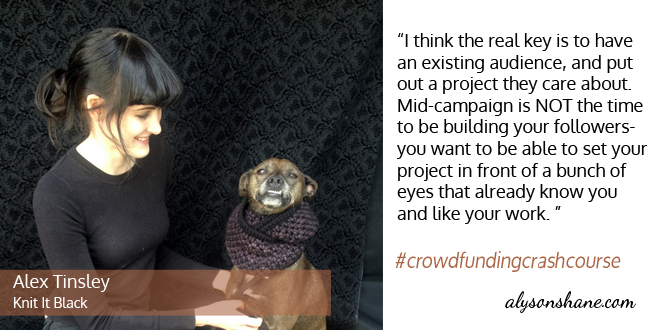
Alex Tinsley has been designing knitting patterns under the label Dull Roar for eight years, and used Kickstarter to fund her project Knit It Black, a collection of all-black knitting patterns.
Can you briefly describe Knit it Black?
Knit It Black is a collection of all-black knitting patterns, designed to raise awareness and funds to benefit animal rescue- specifically, black-coated animals, which have a tougher time finding homes in shelters.
Why did you feel that the crowdfunding model was the best way to promote the project?
Well, my only other choice was to try and fund the whole project out-of-pocket, which may have been do-able, but it wouldn’t have been nearly as good as it can be now. There aren’t a lot of other options for getting funding in this field. Crowdfunding allows people to get involved at the ground floor, support something they believe in, and pre-order the product, in a way.
Why and how did you choose Kickstarter over other crowdfunding options available?
I’ve used Kickstarter before and had a good experience, so I figured, why not? Indiegogo seems like a good option too but I’ve never tried it. Initially I chose Kickstarter because they are the most well-known and widely recognized platform, but when you’re bringing your own audience I’m not sure that choosing one platform over another matters too much.
How big was your budget before you launched your crowdfunding campaign?
Almost nothing, honestly. I made the video with the video functions on my iPhone and Canon DSLR, edited on software that came with my computer; a friend donated the music, and I reached out to my Twitter and Facebook communities for photographs of black pets to use. It’s not a great video, but it gets the point across. If I had been funding the project out of pocket it would have taken a very long time, as I put it together piecemeal between my other work, investing a little bit here and there as I could afford to.
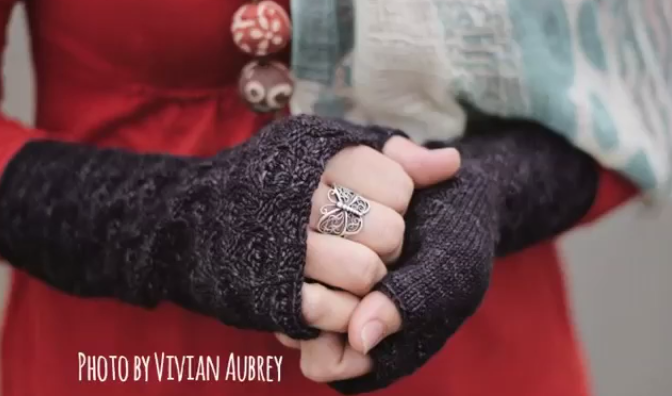
How far along was your project before you felt ready to launch a crowdfunding campaign? In hindsight, would you have preferred to be farther along, or to have crowdfunded earlier?
I had several of the items knit or partially knit, and most of the project planned out in my head, but in July I was offered a good advertising opportunity starting in August and I knew I wanted it to be for the Kickstarter...which meant I needed to get it rolling NOW. Then my photographer had an opportunity to come to town later in August, which means I have to get the knitting done ASAP as well. I feel good about this timeline, though- I work well on a deadline.
Can you explain how you prepared for and managed your campaign?
First I made a big list of all the expenses, to figure out what my goal number needed to be. Then I started brainstorming prizes, and factoring in those costs as well. I reached out to a few people to help me out - the musician, a yarn dyer I had previously mentioned the project to, etc. I was very lucky that everyone was able to work with me on a very quick timeline.
Actually shooting and editing the video was the most gruelling part- I don’t particularly like hearing myself on camera, and dogs never seem to do what you want them to do when you go to record, haha. “Managing” hasn’t been bad- mostly just answering questions as they come up and responding to the feedback I’ve gotten. The real work comes when it ends and rewards need to be fulfilled.
What tools did you use to market your campaign? Do you feel like you did so successfully, and if not, what could you have done differently?
I went through the same channels that I usually use to promote my knit design work - Twitter, Facebook, my blog, my newsletter, Ravelry. It got funded and then some, quite quickly, so I’d say it was successful.
In retrospect what were your best assets for running this successful campaign? On the other hand, what would you do differently?
I think the real key is to have an existing audience, and put out a project they care about. Mid-campaign is NOT the time to be building your followers- you want to be able to set your project in front of a bunch of eyes that already know you and like your work. I don’t think it hurts to appeal to multiple interests - in my case, knitters, animal rescue supporters, and people who like dark fashion. My audience is mostly knitters but I know there’s a lot of overlap.
What was your biggest challenge during your campaign?
Getting it done in a hurry! It’s easy to put off a big project like this, especially when it involves some stuff you don’t really like doing (video, for me) but having a firm deadline really got my butt in gear.
What’s the most valuable advice you could share with aspiring crowdfunders?
Build an audience first- and build the *right* audience! If I have 2000 knitters following me on Twitter and I try to launch a Kickstarter to, say, start a bike company… I’m going to get a lot less response than if I’d matched my project to my audience. Honestly I think that’s far more important than a flashy video or tempting prizes- deliver a project people care about, to the people who care about it.
This post is part of a series! For more interviews and summary posts, check out the Crowdfunding Crash Course page.
Crowdfunding Crash Course: Guillaume Rolland - SensorWake
- by Alyson Shane

Guillaume Rolland is an 18-year old entrepreneur from Paris, France. He is the creator of SensorWake, an olfactory-based alarm clock which wakes you up through the power of smell. He used Kickstarter to successfully fund his project.
Can you briefly talk about SensorWake?
SensorWake is an olfactory alarm-clock. It can wake you up only thanks your favourite scent (hot croissant, peppermint, coffee and even the smell of a dollar!)
Why did you feel that the crowdfunding model was the best way to promote the product?
It’s the perfect worldwide showcase to promote your device or idea.
Why and how did you choose Kickstarter over other crowdfunding options available?
Kickstarter is developing the most powerful community; it is multicultural, curious, and respectful about your project.
How big was your budget before you launched your crowdfunding campaign?
We have to create a great video and great images of our product. We don’t communicate about it but we started with less than 10.000€
How far along was your project before you felt ready to launch a crowdfunding campaign? In hindsight, would you have preferred to be farther along, or to have crowdfunded earlier?
You have to begin the preparation about 4-5 months before.
Can you explain how you prepared for and managed your campaign?
We built a strong team and made sure everyone had strong, unique, and different qualities to be ready for all the challenges we expected.

What tools did you use to market your campaign? Do you feel like you did so successfully, and if not, what could you have done differently?
Facebook Ads are a really great key to market the campaign when it’s live. You also have to showcase your product at a real event. For example we attended the Hello Tomorrow Start-Up Village in June; it’s just the perfect way to demonstrate the real qualities of your product, and to meet your very first backers.
In retrospect what were your best assets for running this successful campaign? On the other hand, what would you do differently?
One of our best assets was that we had a strong community before the launch. We more than 7,500 fans on Facebook before the campaign launch, who were our very first ambassadors who promoted our project.
What was your biggest challenge during your campaign?
Our best challenge is to keep in touch with our backers, we have to be close with them but not spend too much time responding to every email or comment.
What’s the most valuable advice you could share with aspiring crowdfunders?
Take your time before launching, develop a strong community and create the perfect crowdfunding page, do not forget that video is 50% of your campaign success.
This post is part of the Crowdfunding Crash Course series. You can find the full list of interviews and summaries here.
Crowdfunding Crash Course: 5 More Lessons Learned
- by Alyson Shane
The Crowdfunding Crash Course is chugging along and I'm amazed at the overwhelming response from participants and readers alike - I'm learning so much, and am loving the journey of sharing interesting and innovative projects with all of you.
With that in mind, let's review some of the key themes that have emerged over the responses so far and see what we've learned:
1. Organize your team before you start
Kelly Stacey of SoLight, who funded their product SolarPuff on Kickstarter, mentioned that keeping up-to-date with backer questions and special requests was especially taxing. "We had a lot of people asking a lot of questions and getting back to all of them (and we did) was very time consuming" she says, and she isn't alone: every single person I've interviewed has mentioned the tremendous level of organization required to run a successful campaign.
Randy Hoyt, who successfully funded two tabletop games, Relic: Expedition and Lanterns: The Harvest Festival on Kickstarter, took the first and last day off work to make sure that he was available to handle all questions and issues that might come up. "The first and last days of your campaign are the busiest" he says.
The takeaway: if you don't feel like you can handle the planning and execution of your campaign, hire someone or organize a team of people to help you with it. Even things as seemingly simple as responding to backer emails, or interview questions can take up a lot of time, and by delegating and being organized you can make sure you're focusing on what matters: making sure your project is fully funded.
2. Tap into your existing audience
Randy Hoyt from Foxtrot games use the momentum from their first tabletop game, Relic: Expedition to build momentum for their next game Lanterns: The Harvest Festival. They had an existing mailing list from the first Kickstarter which they used to spread the word to people who they already knew were interested in tabletop games, and who had already helped fund the earlier project. Meg from Po-Mo, who funded the interactive projector Lumo on Indiegogo, also tapped into her existing email list to spread the word about their campaign.
When Nils Karlen launched his Kickstarter for Simon Stålenhag's two art books Tales from The Loop and Swedish Machines, Lonely Places, he knew that Simon already had a tremendous following online that they could tap into in order to get funding. Fria Ligen used their own networks to promote the project, but what put them over the top was that Simon leveraged his social media channels and his Tumblr to promote it.
The takeaway: if you have an existing audience, or are working with someone who does, reach out to those people first and let them know about your project. If you don't, spend the time before you launch to build an email list, Facebook page, and Twitter following so that people across multiple social channels can stay up-to-date with your progress.
3. Turn funders into contributors
During his first Kickstarter for Relic: Expedition, Randy Hoyt was hesitant to share the script and rough storyboard for the video with his audience. The second time around, he says, he "realized that feedback was so important" and posted the rough storyboard on YouTube and shared it on Twitter and Facebook so that he could get people's feedback. He also allowed backers to vote on different variations of artwork for Lanterns: The Harvest Festival, which increased engagement and excitement about the project.
The takeaway: By offering backers the opportunity to give their input on things like artwork and design you give them an added incentive to back your campaign: not only are they getting a cool product if your campaign meets its goals, but they also get to participate in the creation of something that interests them.
4. Plan your pledge levels for greater success
Nils Karlen mentioned that during his research for Simon's books that they found that having a very low pledge level (a dollar or two) was an important step to get the campaign started because Kickstarter's metrics consider ever pledge, no matter how big or small.
They also used early bird pledges to incentivize people to start donating early (an early bird pledge is a limited pledge level that is strictly better in terms of price than a comparable level.) By offering limited-time options it mobilizes backers early on, and it also gives you opportunities to promote the campaign by appealing to this sense of urgency eg: "only two more days of our Early Bird $10 option!"
The takeaway: It might seem tempting to only offer pledges at higher dollar values because it will feel like getting closer to your goal faster, but remember that everyone who contributes to your campaign will likely spread the word about it, as well, and you don't want to alienate potential backers by only offering expensive options. Try to create a pledge system with rewards and dollar amounts that appeal to everyone.
5. Don't get discouraged
There will be slow days, no-news days, and days when everything feels as though it's come to a grinding halt. This is normal. What's important is to stay motivated and think realistically, and use those "down" days as days to find other ways to stay motivated and positive about your project.
Tamar Swartz, who used Indiegogo to fund her project Journey to Creative Surrender, mentioned in her interview that she had to remind herself that contributions come in waves, and just because there's a lull doesn't mean that there's a reason to get discouraged, and Mike Raven mentioned in his Traveling Book interview that he also struggled to stay motivated in between donations.
The takeaway: Don't let a slow day get you down! It's totally normal to get stressed out or feel anxious if your project isn't funded within the first few days, but as long as you stick to your promotional schedule and continue to do things like respond to emails, send out updates and stay active on social media you'll soon see another surge of backers.
This post is part of the #CrowdfundingCrashCourse series. You can find the entire series of interviews and summary posts here.
Crowdfunding Crash Course: Stacy Kelly - SolarPuff: A Unique Little Solar Light
- by Alyson Shane
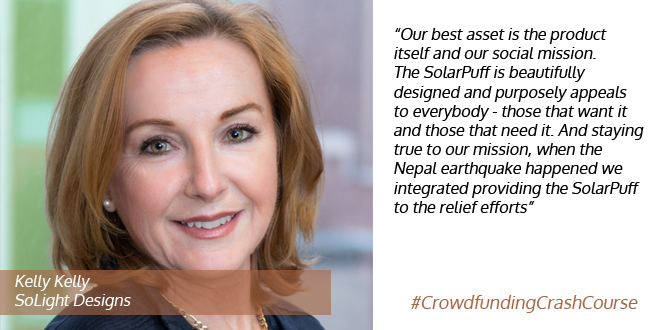
Stacy Kelly is a Co-Founder and Chief Operating Officer of Solight Design. She has the dual role of being responsible for managing the manufacturing and shipment of our products while also developing strategic business relationships, and used Kickstarter to fund the SolarPuff, an inflatable solar-powered lamp.
Can you briefly describe the SoLight SolarPuff?
SolarPuff: A Unique Little Solar Light. It’s a patent pending light-weight solar powered lantern that packs flat and easily pops open. It is made with recyclable material, it is water resistant and it floats. Great for camping, boating and outdoors, as well as disaster relief, emergency lighting and ambiance.
Why did you feel that the crowdfunding model was the best way to promote the product?
We feel that the crowdfunding model provides the opportunity to test your product demand with a large group of early adopters who at the same time will (potentially) provide the funding to get your idea to market. It was never really a question as to whether or not we would go the way of crowdfunding, it was just a matter of when.
Why and how did you choose Kickstarter over other crowdfunding options available?
We chose Kickstarter over the other platforms mostly because of word of mouth. We know a few other people who had run successful campaigns on Kickstarter and due to their experiences we felt more comfortable following their lead. In addition, the Kickstarter platform is extremely user friendly and they make it as simple as possible to get your campaign up and running. They also have a huge community and market aggressively to the community on your behalf and to keep them engaged.

How big was your budget before you launched your crowdfunding campaign?
Budget??? What budget? Seriously, we were fortunate to know some very generous people such as Frederic King, our videographer, who worked pro bono. We used our own social and email networks to get to our initial goal of $25,000. We spent about $200 on Facebook advertising and another $200 with crowdfunding networks. We were advised by other successful campaigners to avoid buying into all the PR companies that approach you, unless somebody you know recommends them.
How far along was your project before you felt ready to launch a crowdfunding campaign? In hindsight, would you have preferred to be farther along, or to have crowdfunded earlier?
The SolarPuff, our first product has been on the drawing board for a few years with patents pending. We launched Solight Design about 18 months ago. We started manufacturing the SolarPuff in Q3, 2014 and completed our website in Dec, 2014 with a soft launch in January. We sold over 1000 units in 2 months. We presented to MoMA in Q3 and got positive feedback and knew now was the time to take it to the public. The fastest and most economical way was through Kickstarter, besides, we needed funding to purchase more inventory. I think we launched at just the right time in our business cycle.
Can you explain how you prepared for and managed your campaign?
We prepared by organizing our email lists and upping our social media outreach. We worked with our videographer and edited until we were happy with it. We fine tuned our “story” over and over again. A big part was coming up with the reward packages to make them authentic to our mission and to promote the product. We had given ourselves an April 22nd campaign launch date and spent the prior 2 months working on all the pieces.
What tools did you use to market your campaign? Do you feel like you did so successfully, and if not, what could you have done differently?
Our marketing campaign was not extravagant. We purchased advertising on Facebook to “boost” our posts, we paid two crowdfunding outreach companies for PR, one of which also included us in their web blog. The best and biggest boost to our campaign came from Kickstarter themselves (unpaid). Once they promoted us as “Projects We Love”, it was a game changer. In 24 hours we raised over $125K. That really put us on the map and after that a number of media outlets contacted us and helped to get us to $447K. “It take a village.”
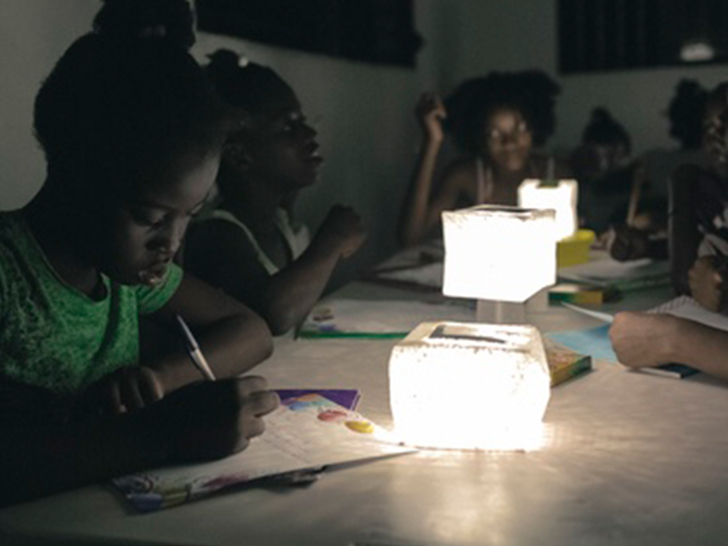
In retrospect what were your best assets for running this successful campaign? On the other hand, what would you do differently?
Our best asset is the product itself and our social mission. The SolarPuff is beautifully designed and purposely appeals to everybody - those that want it and those that need it. And staying true to our mission, when the Nepal earthquake happened we integrated providing the SolarPuff to the relief efforts. I think many people connected with our appeal and were happy to be able to do something to help the Nepali people.
Hindsight is 20/20 of course. What we’d do differently is plan for an overwhelming success and have more product on hand, however it is a catch 22. We went on Kickstarter to get funding for more inventory and now we need even more inventory to fulfill our orders.
We would have been more saavy about “stretch goals”. We didn’t quite understand the value and importance of them to the backers. We really didn’t offer any stretch goals except seeds which were a bust (a story for another time).
What was your biggest challenge during your campaign?
The biggest challenge is staying organized. We had a lot of people asking a lot of questions and getting back to all of them (and we did) was very time consuming. We also had a lot of people making special requests with regard to their pledges (send two to Nepal instead of buy one, give one; ship to a vacation home, wanting to mix and match reward tiers, etc). You need to keep notes on each of these and that too requires time and organization. Now the hardest part is collecting each backers (close to 7000) shipping info and confirming their pledges is another organizational challenge.
So in closing, I will tell you that it was a wonderful, exciting and validating experience. Every hour brought us to a new level. Every backer validated that the SolarPuff is a great product. The comments from most of our backers were so supportive that it would make the most jaded person optimistic.
I think every person with a good product and a good idea should go the crowdfunding route. We were very lucky to have gone wildly over our goal. As the philosopher Seneca, said, “Luck is what happens when preparation meets opportunity.”
This post is part of the #CrowdfundingCrashCourse series. You can find the entire series of interviews and summary posts here.
Crowdfunding Crash Course: Tamar Swartz - Journey to Surrender
- by Alyson Shane
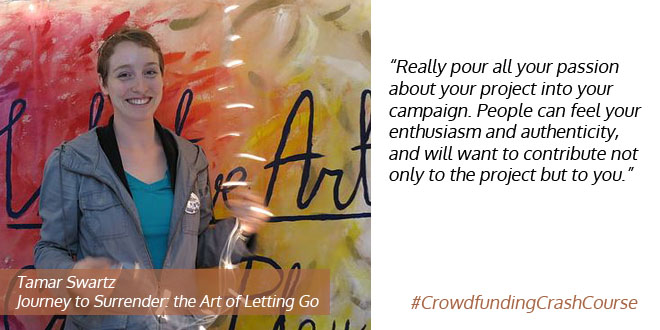
Tamar Swartz is a Canadian mixed media visual artist following her creative intuition in painting, drawing and collage. She used Indiegogo to fund her art project Journey to Surrender: The Art of Letting Go.
Can you briefly describe Journey to Surrender: The Art of Letting Go?
Journey to Surrender: The Art of Letting Go is a creative project currently being developed during a 6 month artist residency in Budapest, Hungary. It’s about following your own creative intuition and allowing a piece of art to emerge and breathe, like any living organism would. It’s about trusting yourself and embracing the creative process while releasing conceptual and intellectual approaches to art making.
Journey to Surrender is a three-part project. Part one is my own mixed media visual art practice and walking the pathways of Creative Surrender. Part two is collaborating with other artists to find Creative Surrender together. Part three is facilitating workshops for local participants to experience this form of expressive visual art making.
Once the project is complete, my experience will be integrated into the Intuitive Art workshops that I facilitate. You can read more here.
Why did you feel that the crowdfunding model was the best way to promote the project?
A large part of the project is to have other people involved and engaging with expressive mixed media visual art and Creative Surrender. Crowdfunding seemed like an obvious choice to spread the word and build momentum about realizing Journey to Surrender. Additionally, once the artist residency is completed, I will be integrating what I have learned into my Intuitive Art workshop facilitation.
Why and how did you choose Indiegogo over other crowdfunding options available?
I looked at Kickstarter as an option, but wasn’t completely sure about the all/nothing model for Journey to Surrender: It seemed like a big leap of faith.
I was also under the impression that my project would have to first be approved by Kickstarter before the campaign launches, a process that takes time. I was on a short timeline and ready to start the campaign. Indiegogo has a really easy to navigate platform and their customer service is very helpful.
How big was your budget before you launched your crowdfunding campaign?
I’m not 100% sure how to answer this question…are you asking about the financial resources that were needed to make Journey to Surrender happen, that I had before starting my campaign? If so, $0. Or, are you asking about how much money I spent building/marketing my campaign? $0 but a lot of time, energy and creativity.
How far along was your project before you felt ready to launch a crowdfunding campaign? In hindsight, would you have preferred to be farther along, or to have crowdfunded earlier?
Journey to Surrender did not officially start until I landed in Budapest, so my Indiegogo campaign was a “pre-project” campaign. Within the week that I received confirmation that my residency application was accepted, I started building my campaign. I drew on my Intuitive Art facilitating experience (2 years) and all my art from my own creative practice. It was now-or-never for me.
Can you explain how you prepared for and managed your campaign?
It took about 2 weeks building my campaign. I spent a lot of time making sure it clearly said what I wanted, adding photos that represented Intuitive Art, and designing perks at different price levels. I asked a few close friends to check it before I launched and got some valuable feedback. Also, these friends were “cheerleaders” throughout the campaign and helped me spread the word about Journey to Surrender.
I also made a timeline of my campaign and set up a schedule of when to send out invites and reminders to participate in the campaign. I was successful in not spamming people. I also made funding goal targets, which turned out to be flexible.
What tools did you use to market your campaign? Do you feel like you did so successfully, and if not, what could you have done differently?
I mostly used social media and personal social networks to market my campaign. I posted on my Facebook, Twitter and Instagram accounts. Hashtag everything!
I also sent a lot of personal emails and Facebook messages to friends, family and acquaintances who I thought would be interested in knowing about my project. I received a lot of positive feedback.
Out of all the generous contributions, only 2 were received from complete strangers. Next time I would like to know how to crack that line between friends/family/acquaintances and complete strangers.
In retrospect what were your best assets for running this successful campaign? On the other hand, what would you do differently?
My best asset for this campaign was my enthusiasm and a really compelling combination of a written pitch, images of my art and perks that were appealing. I received a lot of positive support from friends and family!
I think that having a campaign video could be fun for next time. But, I realized that for Journey to Surrender it wasn’t completely necessary.
What was your biggest challenge during your campaign?
Holding faith that it would be successful. There are days where no one contributes or seems to be talking about it, which is feels like nothing is happening. But, even on those days I had to remind myself that contributions come in waves. It was really incredible how in the last 42 hours people really rallied and funds were literally flowing in. Journey to Surrender ended up being 135% funded! There’s something about the pressure of the campaign ending that motivates people to contribute.
What’s the most valuable advice you could share with aspiring crowdfunders?
Really pour all your passion about your project into your campaign. People can feel your enthusiasm and authenticity, and will want to contribute not only to the project but to you. Be open to surprises! Sometimes the people who you expect to contribute don’t, and the people who weren’t even on your radar do. Don’t take anything personally and always always ALWAYS practice gratitude. Even the smallest contribution is important. Also, be mindful that sometimes contributions are not monetary.
This post is part of the #CrowdfundingCrashCourse series. You can find the entire series of interviews and summary posts here.
Crowdfunding Crash Course: Nils Karlén - Simon Stålenhag's Tales from the Loop” & "Swedish Machines, Lonely Places
- by Alyson Shane
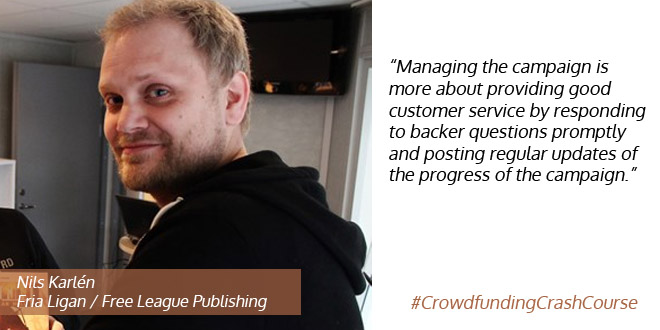
Nils Karlén runs Fria Ligan (Free League Publishing) and managed the Kickstarter for Swedish sci-fi artist Simon Stålenhag's two art books Tales from The Loop and Swedish Machines, Lonely Places.
Can you briefly describe Simon Stålenhag's “Tales from the Loop” & "Swedish Machines, Lonely Places"?
Simon Stålenhag’s digital paintings of Sweden in the 80’s and 90’s mixes science fiction with realistic landscape scenery. His work has been very popular on the Internet and he has been featured and interviewed by Wired, The Guardian and The Verge among others.
I run a small publishing company called Free League Publishing (or Fria Ligan in Swedish) together with some friends and when we first saw Simon’s paintings we fell in love with the mix of sci-fi and the “Swedishness” of the paintings. A friend came up with the idea that we should work together which we thought was a brilliant idea. So we approached him about making an art book together and had a few drinks when we discoverad that we all liked the same John Carpenter movies from the 80’s. Done deal!
The art book “Ur varselklotet” was published last autumn in Sweden and got an overwhelmingly good response. Two print runs later, and a lot of orders from across the world we realized that we had to do an English version as well. As Simon was well ahead with paintings for a second book, we decided it was just as well to crowdfund two books at the same time!
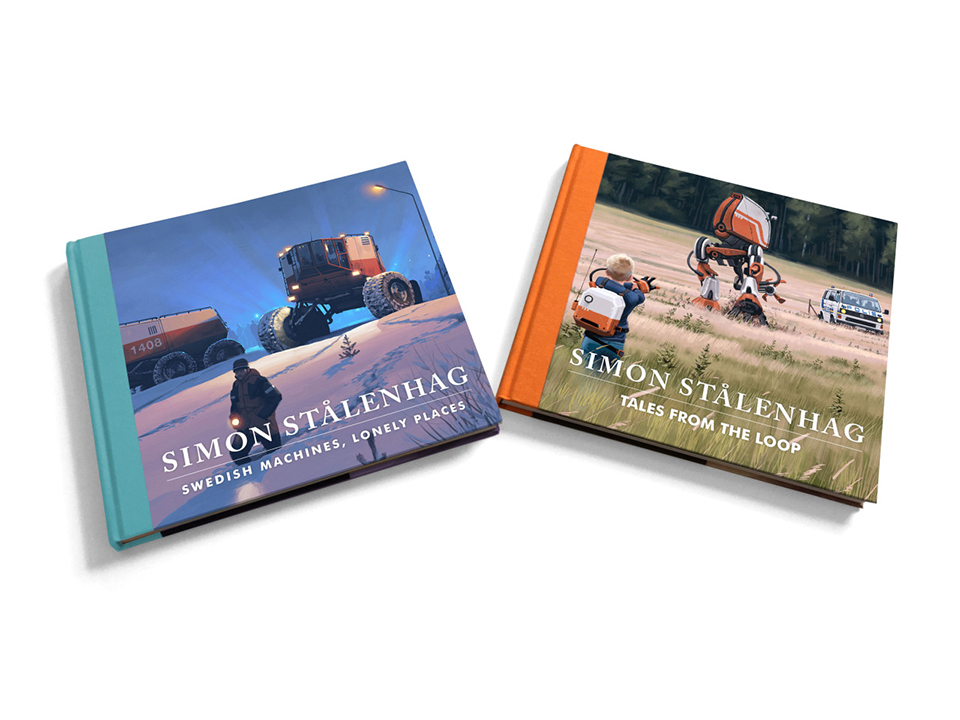
Why did you feel that the crowdfunding model was the best way to promote the books?
It was a natural fit. In part because we knew that Simon already had an enthusiastic fanbase (his Tumblr page has a lot of followers), and partly because we already had done two very succesfull crowdfunding campaigns for our games in Sweden. Also, we knew there was a demand for art books with his paintings as we had received loads of requests from all parts of the world.
Why and how did you choose Kickstarter over other crowdfunding options available?
It was an easy decision. We have previously run two campaigns using the Swedish Fundedbyme for the first and Indiegogo for the second. We really liked Indiegogo and it has a large following in Europe, however when it comes to the US, Kickstarter really is king. So it was natural to choose Kickstarter for this project, and I think the campaigns progress really shows the strength of the platform.
How far along was your project before you felt ready to launch a crowdfunding campaign? In hindsight, would you have preferred to be farther along, or to have crowdfunded earlier?
We are kickstarting two books, the first one was already translated and ready to go more or less. The second one is still in development and as Simon produces maybe one painting a week we are looking at publishing it during 2016. From the perspective of the crowdfunding campaign it would obviously be better if we could deliver both books at the same time, to save shipping costs if nothing more. However, I think it’s really good to be able to deliver something rather quickly, and the first book will be that something!

Can you explain how you prepared for and managed your campaign?
We did have some experience as we had run crowdfunding campaigns in Sweden previously so we the basics covered. However Kickstarter was unknown territory for us so we did do quite a bit of research beforehand. We read articles, looked at some successful campaigns and tried to find common denominators and so on. For instance I learned that having a very low first pledge level (a single dollar or so) is important to get the campaign moving as Kickstarters metrics considers every pledge, big or small. Also early bird pledges was something we picked up during this phase.
Managing the campaign is more about providing good customer service by responding to backer questions promptly and posting regular updates of the progress of the campaign. Also I think it’s very important to listen to the feedback that you inevitable will get from the backers.
What tools did you use to market your campaign? Do you feel like you did so successfully, and if not, what could you have done differently?
We used our own Facebook and twitter accounts to spread the world, but really what made the difference was that Simon himself used his twitter, web page and especially his Tumblr page to market the campaign. We also had a list of international media that we contacted after the launch of the campaign, but initially this met with mixed success as I guess our press release drowned in the mix. However, we got lucky when The Verge featured our project on the first day of the project and word of mouth started to get going, especially through twitter. Since then it has just been snowballing along!
In retrospect what were your best assets for running this successful campaign? On the other hand, what would you do differently?
To be honest our biggest asset was Simon’s paintings. Having beautiful and eye-catching imagery in the campaign cannot be underestimated I think.
The biggest mistake we did was that we did not realize that as a backer you can only choose one pledge level. As we kickstarted two books and had a lot of different levels with just one of the books this proved to be a challenge to handle. It did work out great in the end as we helped backers as much as possible so that they could get both books in the edition they wanted but this one one area where our research did not prove enough.
What was your biggest challenge during your campaign?
To be honest we were taken by surprise the initial success and struggled a bit to provide enough stretch goals to the campaign, so I would definitely say that was our biggest challenge.
What’s the most valuable advice you could share with aspiring crowdfunders?
Do your homework, prepare for success and plan for – if not failure but an uphill struggle. Make sure you got a good set of stretch goals planned and at least an idea of another set if you need to add ones quickly. Also: communicate all the time!
This post is part of the #CrowdfundingCrashCourse series. You can find the entire series of interviews and summary posts here.
Crowdfunding Crash Course: Randy Hoyt - Foxtrot Games
- by Alyson Shane

Randy Hoyt builds websites and runs Foxtrot Games, a small board game publishing company that successfully raised funds on Kickstarter for the jungle-themed Relic Expedition and the Chinese lantern-themed tile game Lanterns: The Harvest Festival.
You’ve successfully crowdfunded two tabletop games: Relic Expedition and Lanterns: The Harvest Festival. Can you briefly describe both games?
Relic Expedition is a jungle adventure game where players act as Indiana Jones like explorers trying to find a set of ancient relics hidden in the jungle. The board starts small, with only a few of the tiles revealed. As players explore the jungle, new tiles are revealed and the board grows in unpredictable ways. For 2-4 players, it plays in about an hour.
Lanterns: The Harvest Festival is a tile-placement game set in imperial China. Players act as artisans decorating the palace lake with floating lanterns. On your turn, you place a tile, which gives every player (even your opponents!) a lantern card based on the orientation of the tile. Players dedicate these lantern cards in various sets to become the most honored artisan before the festival begins. Also for 2-4 players, this plays in about 30 minutes.
Why did you feel that the crowdfunding model was the best way to promote tabletop games?
When we finished designing and developing Relic Expedition, we had a really fun game on our hands that we knew a lot of people would love. We could have submitted it to other publishers, but I think there were two main reasons that we did not. (1) We wanted full creative control over the final product, and (2) we wanted to gain the experience of crowdfunding a physical product. I think crowdfunding made sense for us because we didn't have the upfront cash or the audience, and Kickstarter gave us a way to find a bit of both.
Crowdfunding isn't right for every tabletop game, and it's not a magic bullet: it turned out to be a lot more work than I would have expected. We plan to continue to use crowdfunding for our projects for the foreseeable future, but I suspect that at some point — or at least for some projects — it won't make sense.
You’ve used Kickstarter for both campaigns; why and how did you choose it over other crowdfunding options available?
There is such a strong board game community on Kickstarter. A few people I know have tried other platforms, and they just haven't had anywhere near the success they've had on Kickstarter. If you want to use crowdfunding to raise money for a tabletop game, I don't think there is any other good option right now.
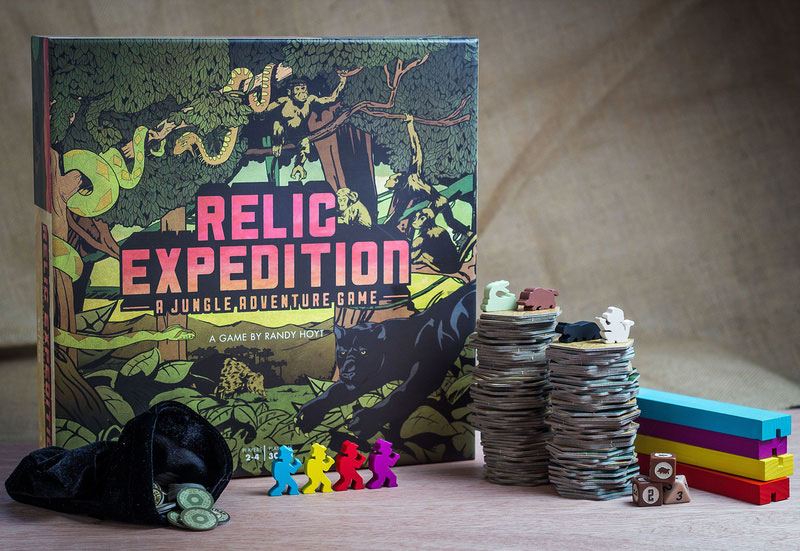
How big was your budget before you launched each campaign?
With each game, we have spent about $4,000 on artwork, review copies, video work, and marketing before the campaign began. We started Foxtrot Games with $10,000 set aside to develop Relic Expedition. We thought the extra $6,000 would give us enough of a buffer in case things didn't go exactly as planned. But as first-time creators, there was a lot about production and fulfillment that we didn't really understand or appreciate until we went through it.
A lot of little things happened along the way (a miscommunication here, a mistake we didn't catch there, a few inaccurate estimates everywhere) that all added up to the project costing more than we had planned. We ended up needing about $15,000 more than we had raised, our initial seed money plus $5,000 or so more. We did have almost 1000 extra copies of the game, and we were fortunate enough to sell a good portion of those in retail to earn back some of our initial seed money.
After Relic Expedition, we had a much better idea of what we needed to do to make a board game that could be profitable. That project had almost twice as many backers, and we are on track to make back a lot of the money we lost with Relic Expedition. On top of that, we have inventory to sell and a much better plan for selling it than we did the first time. We haven't mailed rewards to backers yet, so there is definitely still room for unexpected costs ... but we are in much better shape than we were at this same point in our first project.
How far along were your projects before you felt ready to launch the crowdfunding campaigns? In hindsight, would you have preferred to be farther along, or to have crowdfunded earlier?
The game mechanics were complete for both games before we launched; I think that's essential. With board games on Kickstarter, people aren't backing an idea: they are backing the manufacturing of a game that is finished. This isn't true for every category on Kickstarter, but it's definitely true for board games.
When we launched Relic Expedition, we were not as far along as we should have been. We should have had the box cover done, and we did that with Lanterns: that's a really important piece to sell the game and to set the tone of the project. We should have had more game artwork done so that we could have sent prototypes to reviewers earlier and recorded a game play video earlier: we did both of those things with Lanterns, and they helped quite a bit.
It's interesting now to look back (two years later) at the game play video we recorded during the first week of the Relic Expedition campaign: I only showed three colors of relics because that's all we had done! We finished the first version of all the artwork for the base game during the campaign, but we still had a lot to work to do after the campaign. We had to design the rulebook and the box. We also had to rework some of the pieces: we went through four different versions of the backpack trays before they worked like we wanted, and we changed the colors of the relics once after getting a color proof. We really should have had a lot of that done earlier.
It's not bad to have work to do after the campaign. With Lanterns, we intentionally left some things until after the campaign, things like creating the production files and designing the back of the box. If you don't reach your goal, you would hate to have wasted money on files that you don't need.
How did running the two campaigns differ from one another? Did you learn anything from crowdfunding Relic Expedition that you successfully applied to the Lanterns campaign?
The Relic Expedition campaign funded on Day 30 of 35. After the initial rush, we had a lot of agony trying to figure out how to improve the campaign page and how to get the word out. We spent a lot of time and money on the game itself, but we should also have done so much more to prepare the campaign and promote it in advance.
It's hard as a first-time creator to know what you need to do. For example, we didn't have a video teaching people how to play the game when we launched. We scrambled to make one during the first week; that and everything else we did under the gun during that first campaign took quite a toll on us. We did a much better job preparing and promoting our second campaign in advance, and we funded on Day 6 of 30. That made the campaign so much more enjoyable. I often jokingly tell people asking for advice, "Reach your goal as quickly as you can." It really makes a lot of difference in the trajectory of the campaign — and on you emotionally as a project creator.
What sorts of tools did you use to market your campaigns? Do you feel like you did so successfully, and if not, what could you have done differently?
We did a much better job with marketing and promotion for Lanterns, and we did most of that work before the campaign started. We had started to gather a mailing list when we released Relic Expedition, and we announced to that list that Lanterns would be our next project about three months before the campaign. We shared different pieces of artwork on Twitter and Facebook as they were completed. I also wrote some blog posts about the preparation work I was doing, and a couple of them got shared quite a bit before the campaign. I attended Gen Con and ran some playtests and demos.
Those events went incredibly well: I met some people who became very avid fans of the game and our company, and I also got the confirmation I needed that the game was ready. I mailed about 25 prototype copies to reviewers about 6 weeks before the campaign, and many of them published positive reviews. Those reviews helped promote the campaign to their audience, yes, but more importantly they gave people who found the campaign through other means an idea of whether or not the game was right for them.
During both campaigns, we advertised on BoardGameGeek (BGG). With Lanterns, I waited until we had reached our goal to run those ads. I felt that BGG users would be more likely to back Lanterns after it had already reached its goal. I know that seems backwards, but there's a lot of uncertainty when you back a campaign that hasn't funded. If you pledge, have you spent the money? Maybe. You only get charged if the campaign funds, which may or may not happen. If you pledge, you can’t really spend that money elsewhere. Or if you pledge you might forget that you backed the project (thinking it wouldn’t really fund anyways) and then decide to spend your money elsewhere. It’s just not worth the uncertainty for a lot of people. Once a project has reached its goal, it’s much more straightforward and certain: you pledge, you give the money, and you get a game.

Can you explain how you managed the Lanterns campaign?
Even with all the preparation, running a campaign is still a crazy time. I know project creators who plan everything with a detailed timeline, and I know project creators who fly by the seat of their pants. I lean towards the planning side, but I think it'd be foolish to try to plan everything. It kind of feels like running through a timed obstacle course. A lot happens during the campaign, and you have to be flexible and adapt as it happens.
I took the first day and the last day of the campaign off of work. You get a lot of visibility to a campaign when you first launch, and I wanted to be sure I could answer questions and comments quickly. I planned the dates for the campaign so that I wouldn't be out of town for the first weekend or the last weekend. I had worked to schedule as many reviews and interviews as I could before the campaign, but in those first few days I got a lot of requests from people I didn't know to do more of them. I had 12 review copies on hand that I could send out at a moment's notice, and I ended up mailing out most of them. I checked Facebook, Twitter, and BoardGameGeek quite a bit, responding to questions and sharing updates and comments as they came in.
Sending out regular updates is important. You want to keep the campaign in people's minds and keep them excited, which makes them more likely to share the campaign with others. But you also don't want to annoy them, so updates need to be meaningful. I averaged about two updates a week. Before launching, I had written the text for the first update. It provided a list with links and other information for backers to share the project with others, and I posted that a few hours after launching.
Beyond that first update, I would write the other updates at least the night before and then send them out during the day. I had brainstormed ideas for content that could be used for updates. If there wasn't any news to share, I wanted to be able to share some interesting backstory about the project. The Relic Expedition campaign needed more of those kind of updates because it didn't fund as quickly. With Lanterns, we also had some artwork that backers could vote on, so the news around that process gave me regular content for updates. In fact, I had written the text for an update about one of the components in Lanterns (the favor tokens), but I didn't end up needing that to fill an update during the campaign. So I saved that for after the campaign while we were waiting for the games to cross the ocean and get through the port delays.
What were your biggest challenges during your campaigns?
There's a lot you can do during the campaign to promote it: it could be a full-time job for multiple people. If you have the time, that's great. But if you don't, you have to be really smart about how you spend the time you have. Promoting the project before the campaign works well to get other people excited about it so that they will promote it during the campaign. I spent some extra time beforehand to put things in place to make other things like mailing out review copies take less time: I had extras printed and someone else at the ready to mail them out if I needed them. Again, it feels like running through a timed obstacle course: the better you prepare, the more you can accomplish in that time.
What’s the most valuable advice you could share with aspiring crowdfunders?
You absolutely must share your project as early and as often as you can to get feedback. I know the temptation to have everything perfect before you show your game or your Kickstarter page to anyone. The longer you wait to get feedback from people, the more you will have invested in it and the less you will be able to change. The first few days of a campaign are the most important, and you really want your page as good as it can be right from the start. We made a lot of mistakes on our Kickstarter page for Relic Expedition, and we got some good feedback after we launched; but it would have been much better for us if we had addressed some of those issues before we launched.
I'll give you one example. For both games, I wrote a script for the video and created a really rough storyboard to send to the person creating the video. With Relic Expedition, I didn't want anyone to see this: it was too rough and didn't represent the high quality bar we wanted to set. With Lanterns, however, I realized that feedback was so important. I posted the rough storyboard on YouTube and shared it on Twitter and Facebook so that I could get people's feedback. A few people gave us feedback, and I was able to incorporate that into the final video. We got a lot of feedback on every aspect of the Lanterns campaign from a lot of people, and I knew the campaign page was in good shape when we launched it.
This post is part of the #CrowdfundingCrashCourse series. You can find the entire series of interviews and summary posts here.

